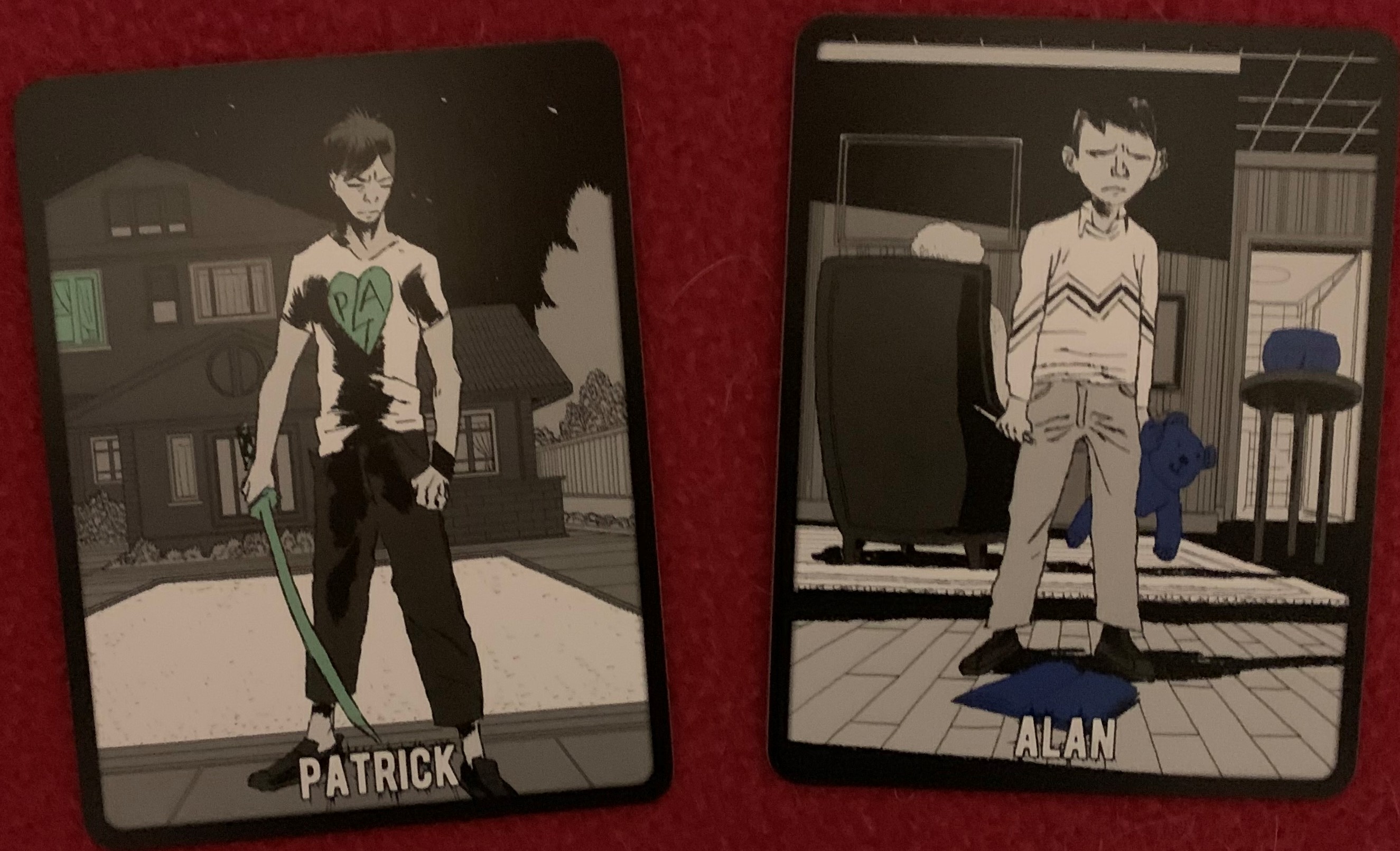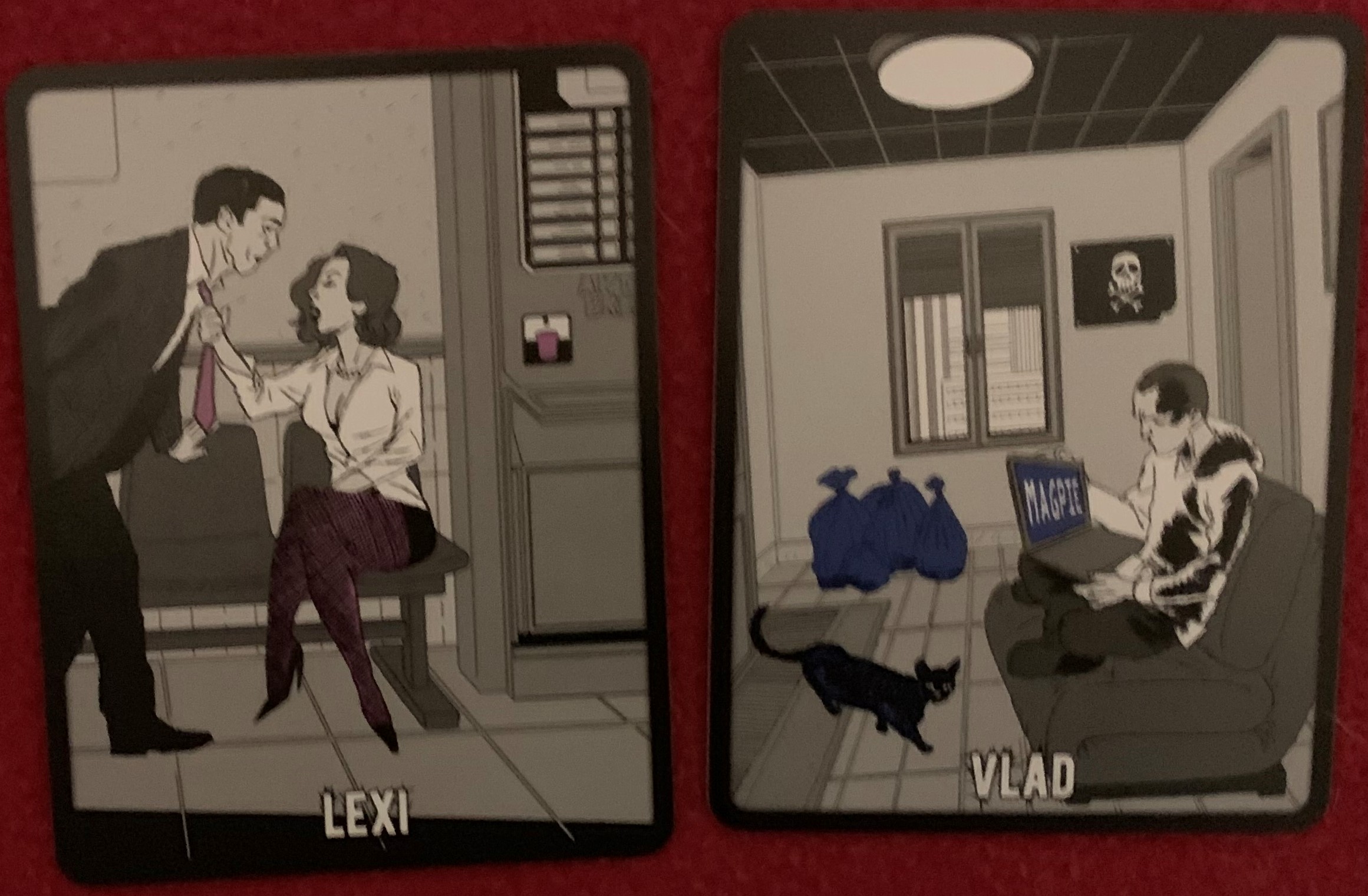
3 Secrets
Designer: Martino Chiacchiera and Pierluca Zizzi
Artist: Werther Dell’Edera
Publisher: DV Giochi
Year Published: 2017
No. of Players: 2–8
Ages: 14+
Playing Time: 15 minutes
Main mechanic / Theme: 20 questions, Cooperative
Can you figure out what is happening from what you see?
Find more info on BoardGameGeek.com (hyperlink)
Overview
As a team of detectives, you must work fast uncovering the secrets of the case before the criminal can get away. One advantage you have is one of your team is an undercover agent. They can supply information, but it has to be done carefully so they don’t blow their cover.
3 Secrets is a cooperative game of deduction. One player takes on the role of the undercover agent while everyone else works with them to solve the 3 mysteries depicted in the scene on the front of the card. The undercover agent is the only player who gets to look at the back of the card. Everyone is working together, but the role of the undercover agent is different (as explained in Gameplay below).
With 4 players we took on a couple of investigations of differing levels of difficulty. It probably would be easier with more players because you have more brains working on solving the case.
There are 7 levels of difficulty identified on the 50 cards. They are identified by the color used on the front of the cards to show the 3 clues to the secrets. For some it was a challenge to stay focused on what we were trying to learn, but luckily there is a response for the undercover agent to help with that.
Gameplay and mechanics
Determine the level of difficulty you want to play. Place a card with the color indicator out where everyone can see the picture. Decide who is going to be the undercover agent. Give them time to read the back of the card. Start your timer.
There are two sets of rules. One is based on using an app you can download. No matter which way you play there are common points that apply.
Everyone is working together to uncover the three secrets of the depicted scene in the picture.
The undercover agent is limited to giving 1 of 4 responses to questions asked: Yes, No, Not Exactly, and It Is Irrelevant. They also have some clues they can share but depending on which version you are playing dictates how that is done. Players who like to be involved in discussing the game are not well suited for playing the secret agent.
The rest of the players can pretty much do what they want, except look at the back of the card. They can inspect the picture, discuss amongst themselves, ask questions, or guess a secret.
With the App
You have a total of 15 minutes to figure out the 3 secrets of the scene. It might be less because you are allotted 5 minutes for each secret. If you discover one of the secrets before 5 minutes lapses, the app is tapped, and the time starts for the next secret.
The secret agent can also give one of the clues during the 5-minute segment. When they do this action, the app is tapped for giving the clue and the remaining time is halved.
If the 5 minutes runs out without a correct guess of one of the secrets, then the undercover agent reads one of the secrets. This takes it out of play for the rest of the game.
Without the App
You have 10 minutes to solve the mystery of the 3 secrets. The time is shorter because clues are given differently, and you don’t have an automatic timer working for you.
The guessing, discussing, and questioning are all the same. It is the giving of the clue from the undercover agent that changes.
Every 3 minutes the undercover agent can read one of the clues to the rest of the team. There is no docking of time.
When Time Runs Out
Scoring is done for everyone based on the number of secrets you identified. There is no individual winner or loser, it’s all about capturing the criminal or not.
Theme, Artwork, and Layout
Working as a team of detectives fits very well for a cooperative game of deduction. Creating a variation of the party game of 20 Questions by moving it into a timed event keeps the pace excitingly intense. Everyone playing needed to stay focused on the scenario because the timer seems to move very quickly while playing.
The artwork is simple black and white drawings, which work well for allowing to see the details of the scene and the highlighted clues to the secrets.
The cards are oversized, making it easier to read what is on the back.
What worked
- Everyone is working together
- Cabin game: compact size easy to transport
- Filler game: limited time of play and really no setup
Final thoughts
The challenge of solving the higher difficulty scenarios was tough, but not so much as to make it no longer fun. For the clues we weren’t able to figure out, it was interesting to find out what they were and how they all tied together.
If you have a gaming group that has good memories, and you enjoy this style of game, then you will want to check out the other installments of the 3 Secrets line. We even had someone talking about making some of their own to see if they could challenge the rest of the group.
If you like the following, you’ll like 3 Secrets.
- 20 question
- Deduction
- Cooperative gaming
- Solving Riddles
About the Author
Daniel Yocom does geeky things at night because his day job won't let him. This dates back to the 1960s through games, books, movies, and stranger things better shared in small groups. He's written hundreds of articles about these topics for his own blog, other websites, and magazines after extensive research along with short stories. His research includes attending conventions, sharing on panels and presentations, and road-tripping with his wife. Join him at guildmastergaming.blogspot.com.






